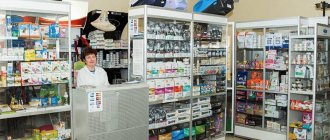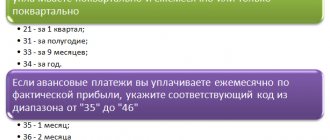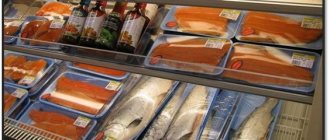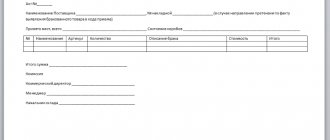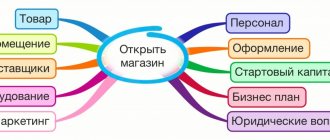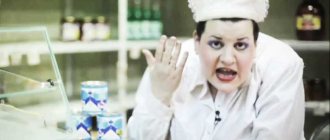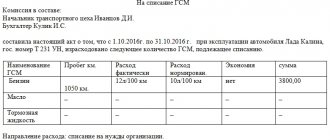Merchandising encourages visitors to make a purchase, as well as increase profits. This is a certain technology for promoting a point of sale, which allows for effective contact between the consumer and the final product. This process includes: convenient display of products, which is combined by color and groups the entire assortment into categories; room decoration; Carrying out promotions and discounts to build customer loyalty. In this article you will learn everything about the concept of merchandising in a retail store, its basics, functions and rules, we will also give a definition and explain in detail in simple words what it is.
What is it like?
The need for an attractive and convenient layout of goods appeared back in the roaring nineties, this was necessary in order to attract customers, since all department stores at that time had the same range of products. To stand out from competitors, the owners of retail outlets resorted to a method such as merchandising; they began to beautifully design display windows, study the appearance of the product, and combine colors. The main task of the aesthetic display of goods is to attract the buyer’s interest and increase the average check.
Do you want to implement “Store 15”? Get all the necessary information from a specialist.
Thank you!
Thank you, your application has been accepted.
Merchandising is an extensive set of activities aimed at creating consumer loyalty to a product, its brand, and manufacturer. The advantages of this marketing method are that it is able to:
- increase sales level;
- increase consumer interest and desire to purchase goods;
- ensure customer trust in a particular manufacturer;
- promote a brand or brand of products on the sales floor.
Goals and objectives
What goals does it pursue:
- Update the assortment;
- Increase sales;
- To interest the buyer in new products;
- Sell stale goods faster;
- Free up space in the warehouse.
The main purpose of rotation is to update the product range and reduce prices. This helps to survive in competition with other owners.
Naturally, in order to update the assortment, it is necessary to analyze all factors, both external and internal.
Analyze, place, compare
A full analysis is made of what sells best and for how long. If a certain assortment sells well, its purchase can be increased. If it does not move at all, then it can be sold cheaply and removed from the assortment altogether or left at a minimum.
In addition, the layout of goods on shelves is of great importance. Sometimes the buyer simply does not see a certain group of things, so it is necessary to draw his attention to them.
The database needs to be analyzed once every six months to see what is popular in the store’s assortment and to make purchases of this particular product. Customers get used to seeing it on the shelves and come for it.
When sales decline, you can offer another product in place of this product.
In addition, the product is seasonal and has a permanent assortment. Seasonal purchases are updated more frequently, which stimulates sales.
Tasks:
- Introduction and withdrawal of positions in order to increase sales;
- Gradual increase in revenue from each position;
- Drawing up a sales plan for certain groups;
- Changing the display as a way to stimulate purchases.
These tasks are set for a store or pharmacy in order to increase profits from a specific point.
Varieties
There are several types of this marketing mix:
- visual;
- cross;
- technical.
Now we will describe these three main types of merchandising and tell you in more detail about the features of each.
Visual
This type is based on personality psychology, economics and design theory. What can be achieved with this method:
- Client perception and interest.
- Artistic and figurative modeling.
- Determination of the properties of each product item.
Visual technology is focused on issues of convenient and correct location of the product, the presence of current price tags, tabular data, signage, and the order of the retail space. Such a tool helps increase sales and successfully promote a particular brand or brand. Buyers prefer retail outlets where they can easily find the product they need and have a large assortment. Perfume and cosmetics companies are the most effective in such promotion; in their windows they have a huge selection of cosmetics, perfume, and accessories. This niche attracts women, because the design of a retail outlet is important to them.
Cross
The key goal here is the display and arrangement of products. Typically, this technique is used by retail companies where a system of full or partial self-service is organized for customers. The main task of this type of tool is the purchase of related products related to the first one.
Examples of schemes:
- Beer - snacks, fish, nuts.
- Meat - seasoning, salt, side dish, vegetables.
- A pack of cigarettes - chewing gum, a lighter.
Often the first product purchased may have a lower price than other purchased items. This technique brings increased revenue.
Technical
The key features of this tool are the use of advertising elements and technical equipment. Advertising may include the following:
- banners;
- promotional stands;
- showcases;
- refrigeration chambers;
- cash register area.
What are the requirements for commercial equipment:
- unobtrusive service that does not cause a backlash;
- reliability in use, devices must be in good working order;
- thoughtful and correct placement of equipment so as not to interfere with clients’ movement around the hall.
Such retail outlets successfully position themselves in the eyes of consumers and effectively maintain their image.
We looked at what merchandising is, gave a simple definition in our own words, and also told us why it is needed and what types there are.
Product rotation: pros and cons
The main advantages of applying the principle of rotation in trade are monitoring the safety of goods, reducing costs for warehouse space and increasing impulse purchases. Competent, timely rotation in the store also allows you to:
- increase the time the buyer spends in the store and the number of product groups he sees;
- make more active use of the consultant’s work, thereby managing demand;
- conduct a comparative analysis of the effectiveness of retail locations and use space more efficiently.
Excessively active rotation can also have negative consequences in the form of loss of customers. A person who every time has to look for where his favorite ketchup is now will next time go to a more stable competitor. This is especially significant for conservative consumers, whose share, according to statistics, ranges from 12 to 18%.
Here you will find all the information on the job description of a store seller.
How can I open a second-hand account and what should I do for this? Read.
How to make money on affiliate sales of various goods and services? This article will describe step by step what you need to do to make a profit.
Methods
Merchandising is manipulation, because visitors do not buy the product that they consider the best, but the one that arouses the strongest interest and favorable impression. What zones is the trading floor divided into:
- areas where customer traffic changes (redirects);
- space near the entrance and exit;
- place near cash register equipment;
- areas near the corners of the room.
An important method when displaying is to lay out the goods from left to right, this is how visitors are used to receiving any information.
Basic Rules
The movement of goods within the store must be subject to special rules in order for rotation to be feasible from an economic point of view.
The following rules must apply in the trading floor:
- All products should be grouped into thematic sections. For example, kefir should be placed next to milk, and a comb should be placed next to shampoos and soaps. You can also place related objects next to certain products - for example, brushes can be placed next to paint.
- Products must be facing the buyer so that he can easily identify the object.
- The first rows must be filled. Do not place products at the back of the shelf - place them on the first row, even if similar products are no longer in stock.
- If you need to sell any items quickly, place them at eye level. A similar rule is true for toys - place children's products at the level of children's eyes so that children can clearly see the entire assortment.
- Adhere to the principle of proportionality - install large, large shelves for selling goods with high demand, and compact shelves or stands are suitable for products with low demand.
- When rotating, do not move the product far from the previous location, since regular customers remember the location well, and if objects are suddenly moved, the buyer may go home empty-handed.
The warehouse should also implement schemes that optimize the trading process:
- Do not block the passage.
- Place high-demand products closer to the entrance to the sales area.
- Place objects with low demand in the back of the warehouse, but do not forget to leave a passage to them.
- Place large, heavy packages close to each other in the center of the warehouse.
- Place small packages in any free space.
Examples and techniques of a merchandising system
We will look at several options for successful design of a store premises.
Pharmacies
All medications are arranged in accordance with the classifier. Information must be understandable and accessible. This way, the consumer will quickly select the necessary product and still have time to choose related products.
Cloth
These retail outlets are distinguished by the following:
- Huge assortment. Popular things should be present in large quantities in the room.
- Convenient location. All products are divided into zones. Cheap clothes are located at the very end of the hall, expensive ones are near the entrance.
- Visual design. Here you can combine colors in different ways, it all depends on creativity and individuality. Mannequins are used almost everywhere.
Grocery store
Here all product items should be divided into groups. A visitor who is interested in buying tea will not pass by the confectionery department. The most accessible areas are the areas near the entrance and in the center. Near the cash register, we constantly pay attention to the location of cigarettes, parquet floors, lollipops, marmalade, chewing gum and magazines. At such points, it is necessary to set up high-quality lighting so that the products look fresh and attract attention.
Types of product rotation
The order of sales, the quantity of products ordered from the supplier, and even the price of the goods depend on properly organized rotation. Depending on these factors, rotation is divided into 3 types: by quantity, cost and timing of product sales.
Quantitative rotation is applied when ordering from a supplier. It is based on the analysis of warehouse accounting and inventory data for previous periods. Depending on the frequency of deliveries, the quantity of products to be ordered is calculated. The stock of goods in the warehouse should be sufficient for the entire time until the next delivery, as well as to ensure that the display cases are filled at the end of this period.
Thus, the order = estimated sales for the period + goods needed to fill the shelves - goods currently on the shelves.
The amount received is adjusted depending on the type of product. For example, if this is a product with a quick turnover, it is better to have it in stock and order it with a reserve. Perishable products must be completely moved from the warehouse to the hall before the arrival of a new batch, and deliveries of goods must be made more frequent.
Rotation by expiration date is carried out so that the goods that arrived at the store earlier are sold first, that is, movements occur according to one of the warehouse accounting methods - FIFO (First In, First Out - first in, first out). This type of rotation fully justifies the daily extra effort and begins to be used already in the warehouse: when new batches of goods are received, the previous ones should be rearranged closer to the aisle, tags on boxes with expiration dates should be located so that the information on them is easy to read.
On the sales floor, you need to ensure that the shelf is always full, delivering goods from the warehouse on time. On the shelf, products with a shorter shelf life are placed in front and on the sides, while freshly displayed products are located in the back. To do this, all products are removed from the shelf, new ones are loaded, and then the old ones are returned, while sorting and removing expired goods.
Rotation by price is carried out when the price of a product changes. Frequently replacing price tags requires significant effort and is associated with a high probability of errors, and therefore customer dissatisfaction. In this regard, it is generally accepted to change the price at the checkout one day after notification of the change. During this time, the old batch will be partially sold out, and the price tags in the hall will be guaranteed to be replaced.
In stores selling over the counter, the price is often changed only after the old batch is completely sold out; in small retail outlets, for example, pharmacies, price tags may be on each package.
Merchandising standards: what are they?
Each store must adhere to an individual standardized system for displaying goods; it must be developed independently, or hired by a specialist from a consulting organization.
The standards provide:
- successful placement of products on display cases and shelves;
- reducing costs for training and courses for employees;
- prompt implementation of a marketing system when opening new branches;
- convenient criteria for evaluating the results of the work done.
Types of rotation
There are three main types of rotation:
- in count. The main parameter is the quantity of certain products, as well as their location (in a warehouse or on the sales floor). Rotation is determined based on analysis of inventory data for the previous accounting period. The frequency of replenishment of a particular product depends on such parameters as the size of the warehouse, the size and structure of demand for goods, logistics costs, and so on. For example, if a product is quickly sold out due to its novelty, then it should be purchased more often, but over time, the frequency of deliveries should be gradually reduced, since the effect of novelty disappears over time. Another example: perishable products need to be ordered in limited quantities, and their remains must be removed from the shelf to the warehouse before a new batch becomes available;
- by expiration date. It is used to prevent products from sitting on shelves. The trading process is carried out according to the “first in, first out” principle. Consider this example: if a store sells clothing, then the new collection should be placed in the window and in the center of the store so that customers can evaluate the new product; after some time, another new collection will appear - in this case, the old collection should be placed at the back of the hall, and the new one should be placed on the display case and in the center; at the end of the cycle, unsold clothes must be sent to a warehouse and packed into boxes;
- by price. Marketers claim that buyers do not like frequent price changes, so price rotation should be performed no more than once a day (usually it is recommended to do this either after the outlet closes in the evening or after it opens in the morning). It should also be remembered that price rotation is often associated with some related activities. For example, if you decide to sell some stale products at a discount, then they need to be placed in the hall so that they are visible.
Retail Tools
It includes everything that is somehow related to selling and attracting customers:
- store design;
- retail store equipment;
- advertising elements;
- staff uniform;
- product layout.
The key preparatory point is to create a layout of products on the display; it is developed based on the preferences of a certain segment of consumers.
Horizontal display
The main goal of this type is to attract people's interest in an unpopular product brand by placing the most popular food products. They are constantly alternated so that the client has a desire to purchase them.
Vertical
Items of the same type are located on one rack in several rows. Small items are displayed on the top shelves, while large items are displayed on the bottom shelves. This kind of display is found in large retail premises of large companies.
Display
The main difference from other varieties is the use of additional elements:
- flocks;
- stands;
- racks.
On them, a certain group of products looks most attractive and effective.
Tools for creating product display planograms
It is obvious that the competent preparation of effective layout planograms is a complex process that requires systematic approaches and solutions. This is especially important for retail chains with a large number of product items and an extensive network of retail outlets.
Pioneer programs in the compilation and design of planograms were MS Power Point and MS Excel . Considering the unconditional popularity and accessibility of these programs, do not forget that the functionality of these merchandising tools is quite limited. Both programs allow you to perform a basic set of functions, such as generating formulas for calculating numbers and indicators, and designing presentations and layouts.
Today, the market offers several specialized planogram designers with a more expanded set of functions and tools. The most popular of them are Planogram Online, Retail Shelf Planner, Shelf Logic . These programs will help you create a database of SKUs and assortments, enter data about retail space and equipment, and create and replicate planograms.
However, the most technologically advanced and modern solution for working with planograms today is automated merchandising management systems. Such systems include ABM Shelf . In addition to multifunctional work with the planogram designer, such smart systems allow you to create a unified database about the display of goods, about the assortment, synchronize absolutely all the numbers with the warehouse management and accounting program, analyze the effectiveness of the display and its impact on sales in real time. The main thing is that the retailer gets the opportunity to manage the entire merchandising process, act strategically and systematically, following the company’s goals and sales policy.
Functions
Now let's look at the main functional features of merchandising. All of them are aimed at increasing the number of sales.
Arrangement of goods in the room
Management is responsible for the placement of product items. In order for the demand for a certain product to increase, the merchandiser must have strong communication skills, be erudite and be able to establish relationships with merchandisers and managers.
In supermarkets, you can increase sales by creating additional points, for example:
- placement of products on branded equipment;
- use of pallet display;
- placement in the cash register area;
- place to sell items.
Promotional materials
They are needed to attract the attention of visitors to the product and tell detailed information about it - about its qualities, useful properties. If any advertisement is outdated, the merchandiser must replace it as quickly as possible.
Collection and redirection of transfer orders
The merchandising department employee must closely monitor the availability of product items. If any product is missing, you must order a new one immediately. Every year the store’s assortment should expand and profits increase.
“Samson” shares layout secrets
Not long ago we wrote an article about how to increase sales using custom displays. Feedback was received on this material - readers expressed a desire to find out how the display is prepared by specialists from the Samson group of companies.
Therefore, we decided to share our secrets - especially since we have been working with the Free Shop program for more than a year and have opened more than a dozen retail stores throughout the country.
On the topic of displaying goods in a stationery store, we talked with the specialists of the Free Shop project, who have been successfully managing the design of new retail outlets of our partners since the start of the program.
What do you think is the fundamental difference between stationery and other goods, such as clothes or products?
The office is distinguished by a large availability of small goods and a huge variety of assortment. This is also a huge group that includes products with different price thresholds - from a pen to a diary.
For more than a year of existence of the Free Shop program, you have probably already studied absolutely all the “pitfalls” of the display. Tell us, what problems does everyone who has to deal with placing assortment on display windows face?
Firstly, correct zoning (distribution of product groups over the entire area of retail equipment), secondly, competent display of goods on retail shelves (you need to choose the right shelf depending on the size of the product and the price tag, arrange everything correctly and neatly so that a potential buyer can it’s easy to find what interests him). It is also necessary to take into account the spontaneity of the purchase - goods that are purposefully purchased (for example, forms, cash register tape, etc.) should not be placed on shelves located at eye level. And, of course, it is important to take into account the direction of the main flow of customers (movement along the equipment in the hall)
From your experience, how should the space be zoned in order to “capture” the maximum flow of customers?
It is necessary to take into account the spontaneous movement of buyers - this is counterclockwise movement. There are three main zones in the sales area:
— entrance area
- cash register area
— zone of the main flow of buyers.
The entrance area (a few meters immediately behind the front door) is responsible for creating a positive mood for customers to make purchases. It is important that immediately behind the entrance to the store there is an unoccupied space (from two steps to several meters depending on the format and specifics of the store) - the buyer should have the opportunity to slow down, take a breath and look around in order to feel comfortable in a new place. him indoors. It is important that the entrance area encourages the visitor to buy something right now. To do this, it contains goods that are visually attractive and desirable: new goods, seasonal goods, attractive impulse goods or goods at a special price.
The cash register area is a “hot”, lively place on the trading floor. There are many impulse items offered there.
The main customer flow area is the most important area in the sales area. It must be carefully planned, because the number of purchases will directly depend on the success of the planning.
Firstly, this area should be highlighted visually - the passage should be wider than others to emphasize that it is the main one.
Secondly, the customer flow is organized by placing different groups of goods in certain places on the sales floor. Consumer goods are in demand every day by the largest number of buyers. These product groups should be located along the outer perimeter of the premises far from the entrance, forming several “golden triangles”, i.e. triangles whose corners are the product group, the entrance and the cash register. On the way to them, we force the buyer to look around the entire trading floor and make impulse purchases.
Is there any specific template that is used for all stores, or do specialists develop a new layout for a new sales area each time?
There are no templates, since each store has its own retail space and assortment content. Therefore, each store develops its own unique scheme.
Maybe there are some tricks, for example, placing a rack with pens opposite a rack with notebooks, and plasticine opposite sketchbooks? What techniques do you consistently use from time to time?
Most often, two layout methods are used: horizontal and combined. The horizontal method is the placement of homogeneous products along the entire length of the equipment, that is, we occupy one or two shelves with each product.
The combined method allows you to effectively use the equipment display area and place more goods on the sales floor, combining goods of the same thematic area. For example, when we put watercolors and gouache on a couple of shelves, we devote several lower shelves to sketchbooks.
If possible, small office supplies should be placed in the checkout area because... This is the category most susceptible to theft. Backpacks (if there is no separately designated area) are placed on top of the racks so that they are clearly visible from anywhere in the store.
Have the display rules changed recently? Previously, for example, all office supply stores had glass display cases and a female salesperson behind the counter. Now there are shops that take your breath away - it’s like being in a museum. Which display will attract more profit?
The type of retail outlets itself has changed. If previously these were closed counter stores, now free access stores are opening, where the buyer can explore, touch and make a choice. Accordingly, the layout has undergone changes. If earlier trade was based on the principle of “showing a copy of the product in the window so that the buyer asks what interests him,” now stores work differently - the full filling of the shelf space with the assortment being sold has come to the fore, as well as its correct combination, leading to purchases not only of the initially sought product, but also of related ones.
A little about the equipment. Which one is most effective? Or is it necessary to use many different racks and racks? Is it possible, if desired, to make do with budget equipment options and not lose in the quality of the display?
Free access metal shelving is a modern and efficient type of commercial equipment. In the store, everything should be arranged and laid out in a presentable, ergonomic and salable manner; accordingly, there is no need to just put in a lot of different “creative” equipment and stands. It is important to look at the need to use this equipment: if there is a product on sale that is better presented to customers in special exhibition equipment, then, of course, it must be used.
For example: you can’t just put pens on the rack; you need special containers for displaying them, so in our stores we always recommend using special “chutes” for display. Or take, for example, greeting cards - they definitely require special racks for printed materials.
Do I understand correctly that the display must change in accordance with the season and calendar holidays?
Of course, the display should change depending on the season or holiday. For example, during the school season, the school assortment comes to the fore and the sales of certain products increase. There should be stands with seasonal goods or baskets with promotional products.
Now the New Year is just around the corner, in a good way, in November it is already necessary to prepare the windows for the influx of buyers who are about to come for gifts. Tell me, what changes need to happen in the sales area so that every potential buyer buys, if not a Galant diary, then at least some kind of keychain or notebook?
If we talk about a classic stationery store, then the demand for business products is increasing here. Business souvenirs, premium pens, business sets, diaries. Small souvenirs and calendars should also appear on the shelves. By this time, many are introducing children's construction sets, mosaics, board games, and, of course, New Year's products themselves. During this period, you can sacrifice space for specialized goods and give this space to New Year's products.
Do you think a person can cope with updating the display on his own, without turning to specialists?
The person himself can put the goods on the shelves, but I think it will be difficult to do it correctly without specialists because it is necessary to analyze the matrix in terms of categories, analyze shelf space, etc.
What is the attitude of the modern Russian consumer to European display trends? For example, in many retail office supply stores in Germany, products are organized by color. In Russia, I personally saw such a trendy store only once; it was semi-stationery (more of a gift theme) and closed long ago. How would such a store be perceived here? Are we not ready for this yet?
As a department, this is quite feasible and effective. But this is impossible to do as a whole store in our country due to the variety of products and designs.
What should you focus on when creating a display for a retail store?
It is necessary to focus on understanding the movement of customer traffic throughout the store’s sales area, take into account the arrangement of retail equipment, and the features of the product that will be on the shelves (who is the potential buyer, price, packaging).
Name five basic rules for competent and effective display.
- Products must be placed with the front side facing the buyer and in such a way that they are visible in their entirety, without blocking each other.
- Price tags must be truthful, aesthetic, correspond to the product and contain easily readable information.
- It is important to provide an accessible path to the goods in the hall, free access to the goods on the shelf;
- It has long been established that goods sold best are those placed at eye level with the buyer. Therefore, it is worth placing here either goods that need to be sold quickly, or the most profitable goods.
- You constantly need to monitor the fullness of the display cases, not letting them become empty. The motivation is obvious: empty shelves do not mean anything good to the buyer. But the abundance of goods, on the contrary, pleases buyers.
We appreciate your insightful responses and hope these tips provide great motivation for you to improve your retail store display.
And if you want to contact our specialists and redesign your store or open a new retail sales point, you will need to leave your application on the website www.myfreeshop.ru
Valuable advice on designing product groups and retail premises
We will give several recommendations that will allow you to efficiently organize the work of the merchandising service and correctly display the categories of products sold.
Showcases and their placement
In each hall there are popular areas where people’s interest and attention are always shown, but there are also “blind spots” - these are points that do not attract visitors. The first category includes places:
- near the entrance and exit;
- near turns;
- next to the cash register;
- corner areas and counters.
It is necessary to take advantage of these opportunities and place positions in such areas as much as possible. Then profits and sales levels will increase.
Signs
A person should not rush between racks and search for the right products for a long time. Employees should set up a navigation system and post signs throughout the hall with information about departments.
Commercial premises
Each company must have its own corporate individual style, and the interior fully corresponds to it. Merchandising service employees have the right to place flavors that whet the appetite of visitors, as well as include musical compositions and advertising sound elements (information about promotions and discounts).
Entry group
This area should contain products that best satisfy the needs of customers; they must be lured and encouraged to make a purchase. However, it is better not to clutter up the space too much, since the client will not be able to look around the entire room.
POS materials
In order for a person to quickly and easily find the right product, managers should think about print advertising, which is:
- various types of leaflets;
- beautifully designed price tags;
- attention-grabbing flags;
- navigation signs;
- glowing garlands;
- stands for goods.
An excellent solution for automating merchandising activities will be the “Store 15” software from Cleverence; it simplifies the inventory process, as well as the revaluation of the product range.
Drawing up planograms: step-by-step instructions
The sales floor/sales equipment planogram is a reflection of the sales and marketing strategy, based on the laws and principles of merchandising, applicable and customized to the goals and objectives of each specific retailer. When drawing up planograms, it is very important to understand two key points:
- A layout planogram is not a static document . A showcase planogram is not a diagram that can be created once and used for many years in a row. This will be extremely ineffective, because demand and purchasing habits change very quickly and dynamically, the assortment becomes obsolete, goes out of fashion, undergoes rotation, suppliers introduce new products, and so on. On average, a retailer changes display planograms 3-4 times a year, at least. Industry experts advise reviewing and adapting planograms once a month.
- The sales floor planogram should be built and based on the general principles of merchandising, but reflect the goals of a specific retail outlet , which, in turn, is based on the assortment, financial, pricing and promotional development strategy of the company. Each retailer must understand which product categories and which SKUs in its assortment are targeted, and which products should receive top positions in the display, acting as sales engines. This data on products can be obtained by analyzing consumer demand and sales levels of previous periods or in real time - we described how to do this here.
Once the retailer establishes and understands the goals for sales and promotion of its products, you can begin the first stage of creating a planogram:
Step 1. Development of a concept for a store/outlet/commercial equipment
At this stage, the general direction of the style and type of display is created and generated, retail equipment is selected for each product category, brand, price category, etc. The selection should be carried out in such a way that each product is displayed as openly, visually attractive, and corresponds to the trajectory of the buyer’s movement in the store. The product should be displayed in such a way as to encourage a quick purchase.
Step 2. Schematic drawing of developments
After the products are divided into categories, the shares of each product in turnover are calculated, a sales strategy is thought out for each category and the optimal display is selected, you need to schematically display all these developments on a planogram.
The display planogram should be very informative and contain all technical parameters and details, such as the size, type and dimensions of retail equipment, the area of the sales floor, the number and type of facings, product identifiers - color, size of product packaging, number of SKUs displayed on the display, price tags, possible instructions and guidelines from marketers and brand managers, and so on. With such an abundance of information, the display planogram should be easy to read. Modern planogram designers allow you to do this easily and effectively.
Creating a directory of goods and equipment for placement on a planogram in ABM Shelf
Step 3. Approval and control
Mandatory approval of the planogram by the owner/management of the company and replication to retail outlets, with mandatory reporting and monitoring of implementation.
Just a few years ago, control of layout according to the planogram and its compliance was carried out manually. Reconciling the display and recording all changes on all versions of the display planograms without confusion took quite a lot of time and effort from store staff, merchandisers and category managers. Modern merchandising management systems allow you to automate control over planogram implementation, monitor display in real time and transfer the entire reporting system to a smartphone, as well as instantly make changes and edits to planograms.
You can see a real example and results here.
When merchandising doesn't work
- The company sells only cheap or expensive products.
- The organization sells a product that is unfamiliar to anyone.
- The range includes cars, real estate and large household appliances.
- If it is necessary to demonstrate the product being sold in action.
- Too wide range of identical trading items.
In this article, we explained what is called merchandising in a store, talked about the basic principles, rules, standards and functions, and we also examined all the concepts and terms of marketing activities.
Number of impressions: 1650
Principles and functions
The purpose of rotation is to increase profits by changing some parameters of the trading cycle (increasing or decreasing the number of goods on the shelf, recalling old products to the warehouse and placing new ones, changing prices, and so on). Rotation, along with advertising, is one of the main methods of promotion. Typically, rotation is used to promote the following types of products:
- everyday items. Basically, food, household chemicals, simple household appliances and some clothing usually fall into this category.
- Objects of cultural value. This could be books, DVD movies, music, and so on. Such objects are especially sensitive to rotation, since people follow new releases and do not want to buy old books and films (with the exception of classics);
- so-called passive demand products. This category includes objects that do not have very high practical value, but which have a stable demand. The main examples are unusual food and clothing, souvenirs, some children's toys, and so on.
However, some products are not very sensitive to rotation. For example, in the case of furniture trade by pre-selection, rotation is not of serious importance. The previous example is also true for the market for expensive cars, luxury alcoholic beverages, computer equipment, and so on.
Advantages and disadvantages of rotation
There are many advantages to proper rotation.
Main advantages:
- stimulating purchasing activity, which leads to an increase in total revenue;
- saving free space. Due to savings, you can reduce the costs of maintaining a warehouse and storing goods;
- increasing the total time a person spends in the store. The more time a person spends in a store, the more likely he is to buy an item that he would not normally purchase;
- almost zero cost. Some studies show that rotation is comparable in effectiveness to advertising, and its implementation does not require any additional costs;
- Constant movement allows you to monitor the quality of goods.
However, rotation also has several disadvantages. The main disadvantage is that excessive activity can reduce consumer demand - if a person is used to buying the same product in a certain place, then constant movement can confuse him.
Also, rotation is ineffective in some areas of activity. For example, in the case of custom-made furniture, the placement of goods in the store has little effect on customer activity.
Rotation functions
Product rotation is one of the promotion tools, part of merchandising. Its main goal and function is to stimulate the buyer to purchase the product. As part of achieving this goal, rotation should create in the buyer a feeling of constant updating of the assortment and freshness of products. There are rules for product layout that help increase sales. Rearranging products and display features help increase sales. It is human nature to pay attention to new things and experiment with purchases. Moving a product increases search behavior and also drives sales. Rotation also allows you to speed up the changeover of the assortment and helps quickly get rid of stale products. Any grocery store knows what problems arise with products that have expired, and one of the sales tools here is rotation. Quick sales of goods allow you to speed up the release of warehouse space, which also leads to cost minimization. Of course, this method is not a panacea, it has both advantages and disadvantages, but it is one of the effective tools for stimulating sales and optimizing costs.
In what areas of activity is it used?
Rotation as a term is used in many areas. For example, in printing
This is the operating principle of a machine that prints advertising and printing products. The name comes from the working element, the shaft, which has the shape of a cylinder. We remind you that rotation is rotation.
In architecture
- this is a feature of rotating the body around its axis when constructing a sculpture. This action is necessary for a more vivid perception of the image as a whole.
In geography
– for example, in navigation, rotation means the movement of a ship in a circle when it goes with cargo, not returning to ports, but along the route.
In agricultural work
Rotation means crop rotation. That is, after 4 years, the land is sown with other crops to increase its fertility and productivity.
In television and radio broadcasting
– rotation is a change of gear or picture. The clips alternate with films, advertisements and other videos.
In medicine, rotation is understood as displacement. For example, rotation of the vertebrae relative to each other. In addition, there is rotation of the head, hip, and shoulder.
In sports, rotation is a change of players on a team or a redistribution of roles: an attacker becomes a defender or goalkeeper.
In the work activity of personnel, rotation can be the replacement of employees from neighboring departments, transfer from one position to another, often with promotion. May increase: range of duties, responsibility, earnings. An employee can also be sent to another city due to official needs, but all this is within the same structure.
Rotation means constant updating of the roster, which is why it is so popular. There is a constant search for new opportunities with growth prospects.
In commodity science, the term rotation is used in terms of updating the product range. This must be done, since the buyer is not interested in going to the store and seeing the same thing on the shelves. New products stimulate consumer interest and encourage purchases.
Also, rotation of goods is used when receiving products, when fresh goods are placed on the shelves further away, and old ones are laid out closer, so as not to go past the sales date.
Where do I use it?
In the sales area
The sales floor uses the basic principles of display according to merchandising, which allows for improved sales.
Layout rules:
- Facing customers;
- Main brand;
- Priority shelf;
- Lower and upper shelves;
- Rotation, when the later product is removed in depth, and the product arrived earlier is as close as possible to the buyer;
- Placement according to package size;
- Placement among competitors.
Compliance with this display principle helps speed up sales and save money.
In warehouses
To avoid confusion and prevent goods from sitting in the warehouse, there are several rules for storing inventory items.
How to organize your storage space:
- Your place, cell, shelf must be determined. It is best if this data is entered into a PC, it is more convenient to carry out reconciliation.
- The most popular items are stored closer to the shipping area.
- For static storage places. For dynamic – any free space will do.
- Bulky ones are stored in the shipping area, regardless of their demand, but small, but valuable ones, albeit with a high turnover, are stored in the depths of the warehouse.
These and other rules allow you to quickly and efficiently ship without violating delivery deadlines.
At the distribution center
The distribution center becomes the main one in the rotation chain. He makes purchases of certain groups, which he then delivers to the warehouse, from where he distributes them to different points.
This is the most profitable management system, since large purchases of goods cost less.
To ensure that it does not linger in the warehouse, the distribution center must always know exactly the remaining goods in each link of the network and the sales that have taken place over a certain period of time.
Centralized trade turnover is much more profitable and allows you to save money when purchasing new batches of goods.
Price rotation
Rotating goods based on cost is quite difficult. One of the characteristics of price is variability. Sometimes prices change every day, which is especially true for some product categories.
Constantly changing prices is irrational, it can lead to confusion and customers will be unhappy. To eliminate such risks, stores usually sell goods from past deliveries at the old cost. Products from new batches are sold at an updated price.
Rotation should always be done, regardless of the specialization of the trading enterprise. Otherwise, losses will occur after some time. You need to follow the rotation method from the very beginning of the store. Otherwise, a situation will arise when some goods are stored in a warehouse for several years and are not sold.
Proper rotation is a labor-intensive operation, but worth all the costs associated with it. With thoughtful rotation, goods will be sold more actively, there will be no overload in warehouses, as a result of which the company will avoid losses.
This is also one of the important competitive advantages. Proper rotation is one of the key principles for increasing sales volumes.
Rotation Strategies
Experts, answering the question of what product rotation means, note that it is not just “rotation” of goods in a store. This is careful planning, analysis and thoughtful rearrangements. The merchandiser and merchandiser must conduct demand analytics and, in accordance with this, conduct the purchase of goods and their movement in the warehouse. Proper procurement and warehousing helps reduce storage costs and minimize the amount of goods written off. To ensure proper movement of goods, the company must develop a unified rotation strategy, which includes logistics, promotion and merchandising solutions. These strategies can be based on stimulating trial or repeat purchases, using knowledge about consumer psychology, and economic and pricing mechanisms to stimulate demand.

